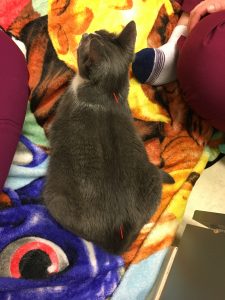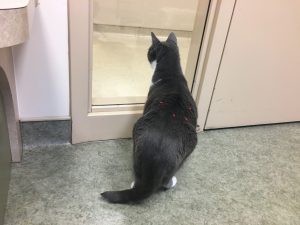Written by a CuraCore Veterinary Medical Acupuncture course graduate. Signed release obtained from client/author. 3D2019004
ABSTRACT:
Feline stomatitis and hyperesthesia syndrome in an approximately 4-year-old spayed female domestic medium-haired feline. Traditional western medicine approaches combined with integrative medical treatment modalities included gentle massage, skin rolling, laser, and acupuncture. After 4 treatments and complete full mouth dental extractions, stomatitis and hair coat abnormalities resolved while hyperesthesia improved within subsequent days of treatment. Initially, the patient was receiving Depo-Medrol injections approximately every 6 weeks to resolve the stomatitis. After patient’s full mouth dentition extractions, this medication was discontinued.
HISTORY OF PRESENT ILLNESS AND CHIEF COMPLAINTS:
Lucy presented to the Michigan State University Veterinary Teaching Hospital (MSU VTH) Primary Care Service on March 20, 2019 with a presenting complaint of stomatitis (previously diagnosed by her primary care veterinarian [rDVM]) and muscle fasciculations induced when touched on dorsal epaxial muscles caudal to rib thirteen. Lucy was adopted by her owner from a previous owner who was unwilling to treat her medical needs. Her previous home consisted of two adult humans, two children, and multiple pets, including dogs that reportedly chased Lucy. Lucy experienced one pregnancy prior to adoption. The pregnancy resulted in a dystocia resolved through a Cesarean section with ovariohysterectomy and no surviving kittens. The length of gestation and number of kittens in the litter is unknown. Lucy’s current household consists of two other spayed female cats and two adult humans. One of the other cats in the household participates in occasional allogrooming with Lucy. No signs of aggression exist between any of the cats. Lucy has a good appetite for canned food and lives indoors only. Lucy occasionally bites her own tail, interpreted by the owner as play behavior. Feline immunodeficiency virus (FIV) and feline leukemia virus (FeLV) status unknown.
6 Lucy Video Nov 15, 2019 exiting carrier
PHYSICAL EXAMINATION AND CLINICAL ASSESSMENTS:
03/20/2019: On initial presentation physical exam findings included: Temperature: 101.5◦F; Pulse: 160 bpm; Respirations: 30 brpm; Body Condition: 6/9; Mucosal Membranes/Capillary Refill Time: pink (capillary refill not attempted due to oral pain). The patient presented bright, alert, and responsive with a generalized rough haircoat with mild saliva staining noted on the white areas of her front paws. Mild ptyalism and halitosis were present. While a complete oral examination was not possible due to the level of oral pain, a brief exam by lifting the lips revealed adult dentition with severe, generalized inflammation bilaterally of the maxillary gingiva. Eyes and ears were clear. Heart and lungs auscultated normally with no crackles or wheezes. Abdominal palpation was unremarkable; no hernias palpable. Thoracic limbs bilaterally declawed. No proprioception deficits present. Appropriate mentation noted.
11/15, 11/20, 11/22/2019: Patient vital signs were within normal limits. The patient presented bright, alert, and responsive. Oral examination revealed absent dentition with normal gingiva. The rest of the physical exam was unremarkable. Positive FIV and Bartonella tests, and negative FeLV test, per rDVM.
03/20, 11/15, 11/20, 11/22 2019: The patient appeared to have normal range of motion at a walk.
Although gait/range of motion could not be completely assessed due to patient’s tendency to walk short distances and then sit while exploring the room. The patient appeared to walk with more weight distribution on the metacarpal pads of the thoracic limbs than would be expected. This shift in weight may be attributed to the declawed paws on these limbs. The removal of the P3 digit in declawed animals requires a new gait compensation as P2 bears the majority of the weight in this new anatomical reconfiguration. Myofascial palpation: mild ropey bands bilaterally on triceps and dorsal cervical region. The area of epaxial muscles over the lumbosacral region caudal to the thirteenth rib elicited muscle fasciculations and tail twitching upon palpation. Whether this reaction was due to pain, behavioral, or neurologic reasons was undetermined, partially due to lack of further diagnostic testing (ex: radiographs). The patient did not appear distressed by stimulation in this area and neither attempted to move away nor bite.
PROBLEM LIST:
1. Feline hyperesthesia syndrome
2. Stomatitis (generalized, severe, chronic inflammation of gingiva and epithelium of oral cavity): resolved after full mouth dental extractions July 2019 by rDVM.
3. Feline immunodeficiency virus (FIV) positive status
4. Rough haircoat: resolved after full mouth dental extractions July 2019 by rDVM.
5. Bartonella positive: assumed resolved, treated with Doxycycline April 2019 (6 weeks) by rDVM.
6. Ambulation deficiency-mild: assumed secondary to onychectomy
DIFFERENTIAL DIAGNOSES Top Two Problems:
1. Muscle fasciculations of epaxial muscles induced by stimulus to area:
• V(ascular): Thrombosis or another vascular compromise/impingement in epaxial region
• I(nfectious): Infectious dermatitis-fungal (unlikely)
• N(eoplastic): Brain tumor-meningioma
• D(egenerative): Spinal degenerative joint disease or arthritis
• I(atrogenic, intoxication): Compensatory backpain secondary to ambulation deficiency
• C(ongential): Compulsive disorder, anxiety, feline hyperesthesia syndrome (most likely)
• A(utoimmune): Atopy, polymyositis
• T(raumatic): Previous fractures-tail, pelvis
• E(ndocrine, metabolic): Xeroderma due to omega-3 fatty acid deficiency, hyperthyroidism
• M(yofascia): Pain attributed to restricted myofascial components
2. Generalized, severe, chronic inflammation of gingiva and epithelium of oral cavity
• V(ascular): Thrombosis secondary to renal failure (unlikely)
• I(nfectious): Stomatitis secondary to FIV and/or Bartonella spp.
• N(eoplastic): Squamous cell carcinoma or fibroma
• D(egenerative): Periodontitis
• I(atrogenic, intoxication): Failure of veterinarians to perform proper oral examination during wellness visits to discover early oral disease
• C(ongential): Fungal stomatitis secondary to under developed immune system
• A(utoimmune): Immune mediated response to oral bacteria and calculus (likely)
• T(raumatic): Electrical cord trauma or wax-melts burns (unlikely)
• E(ndocrine, metabolic): Uremia secondary to chronic renal failure (unlikely)
• M(yofascia): Pain attributed to myofascial components of masticatory muscle pain/spasm
DEFINITIVE DIAGNOSES:
Based on history, physical exam findings, clinical presentation of signs, diagnostic laboratory findings, and response to treatment, the definitive diagnoses include feline hyperesthesia syndrome, stomatitis, FIV, and bartonellosis. During the course of treatment, the stomatitis and bartonellosis resolved through the intervention of traditional western medicine.
MEDICAL DECISION MAKING: Acupuncture treatments
Points used Reasoning behind point selection Method Frequency
ST2 & ST4 Maxillofacial/orofacial pain through stimulation of infraorbital nerve Acupressure 03/20/2019 clinic treatment then at home by owner daily until dental extractions
GV20 Relaxation, anxiety reduction, peripheral stimulation Dry needling 03/20/2019
11/15/2019-attempted not well tolerated
GV14 Neck/back pain through stimulation of cervicothoracic spinal nerves Dry needling All treatments starting 03/20/19
Bai Hui Masterpoint of hind end, autonomic neuromodulation Dry needling All treatments starting 03/20/19
BL23 (bilaterally) Thoracolumbar pain and possible pelvic pain through thoracolumbar spinal nerve stimulation Dry needling All treatments starting 11/15/19
BL 27 & 28 (bilaterally) Sacroiliac pain/dysfunction through S1 & S2 spinal nerve stimulation Dry needling All treatments starting 11/15/19
6 Lucy Video Nov 15, 2019 exiting carrier
MEDICAL ACUPUNCTURE AND RELATED TECHNIQUES USED:
03/20/19: Light massage during palpation/myofascial examination. Acupuncture points utilized: GV20, GV14, Bai Hui for 10 minutes. After placing these points, patient returned to soft floor mat and appeared to fall asleep in dorsal recumbency. Fewer points were used during this session to assess patient tolerance and build trust with Veterinary Medical Acupuncture Course (VMAC) student. MR4-Activet laser (stomatitis settings recommended in Activet manual) applied bilaterally to the mandibular and maxillary region for three minutes total. Patient tolerance decreased after three minutes and the laser was discontinued. VMAC student demonstrated and discussed acupressure of the ST2 and ST4 regions of the face for at-home treatment by the owner (as tolerated) to address maxillofacial/orofacial pain.
• Seirin J #1-tubed (0.16) x 30mm dry needle for this and all remaining treatments.
• Testing for FIV, FeLV, and Bartonella spp. discussed with the client to rule out possible contributing factors to patient’s stomatitis. Tests performed later by rDVM.
11/15/19: Light therapeutic massage with myofascial skin rolls over entire body to facilitate increased circulation to the tissues and provide relaxation. Acupuncture points utilized: GV14, Bai Hui, BL23, BL27, BL28 for 15 minutes. After placing these points, patient reclined under a bench in the room in lateral recumbency and appeared to fall asleep. GV20 was attempted, but was not well tolerated and resulted in agitation and distrust from patient. Patient eventually recovered and approached VMAC student again accepting additional point applications. However, due to the resulting loss of patient trust and appointment time created by placing this previously well tolerated point, GV20 was abandoned during future treatments.
11/20/19: Light therapeutic massage with myofascial skin rolls over entire body to facilitate increased circulation to the tissues and provide relaxation. Acupuncture points utilized: GV14, Bai Hui, BL23, BL27, BL28 for 15 minutes. After placing these points, the patient reclined under a bench in the exam room in lateral recumbency and appeared to fall asleep.
11/22/19 Light therapeutic massage with myofascial skin rolls over entire body to facilitate increased circulation to the tissues and provide relaxation. Acupuncture points utilized: GV14, Bai Hui, BL23, BL27, BL28 for 15 minutes. After placing these points, the patient walked around the room finally settling in front of an exam room window to watch the hallway activity for the remainder of the treatment.
During all acupuncture treatments, the patient was reinforced with reward-based conditioning including scratches/petting, ProPlan adult salmon and tuna entrée canned food, and Friskies party mix crunchy cat treats. The blankets and towels used during the treatments were sprayed with Feliway Classic pheromone spray at least 15 minutes before contact with the patient. The VMAC student also sprayed her clothing with Feliway Classic pheromone spray at least 15 minutes before contact with the patient


 10 Lucy Final Video after treatment Nov 22, 2019
10 Lucy Final Video after treatment Nov 22, 2019
OUTCOMES, INSIGHTS, DISCUSSION:
Lucy’s case provided an excellent opportunity for acupuncture therapy. At the start of the November treatments, acupuncture was the only modality utilized, and the owner reported reduced hyperesthesia symptoms in the two days directly following each treatment. Lucy exhibited less severe muscle fasciculations and decreased frequency of tail biting with each treatment. Diminishing hyperesthesia symptoms will require continued acupuncture therapy possibly in combination with laser therapy and/or pharmaceutical intervention (ex. gabapentin).
REFERENCES:
Sudarshan R, Annigeri RG, Mamatha GP, Vijayabala GS. Uremic stomatitis. Contemporary Clin Dent. 2012;3(1):113–115. doi:10.4103/0976-237X.94560
Winer JN, Arzi B, Verstraete FJ. Therapeutic Management of Feline Chronic Gingivostomatitis: A Systematic Review of the Literature. Front Vet Science. 2016;3:54. Published 2016 Jul 18. doi:10.3389/fvets.2016.00054